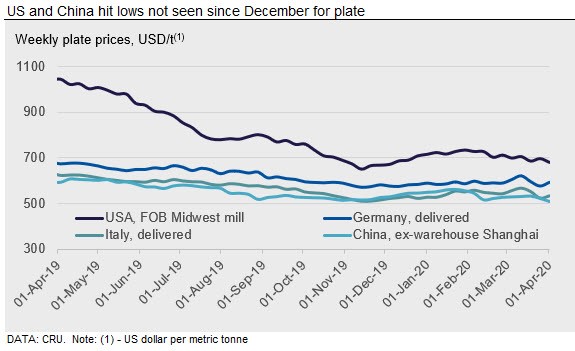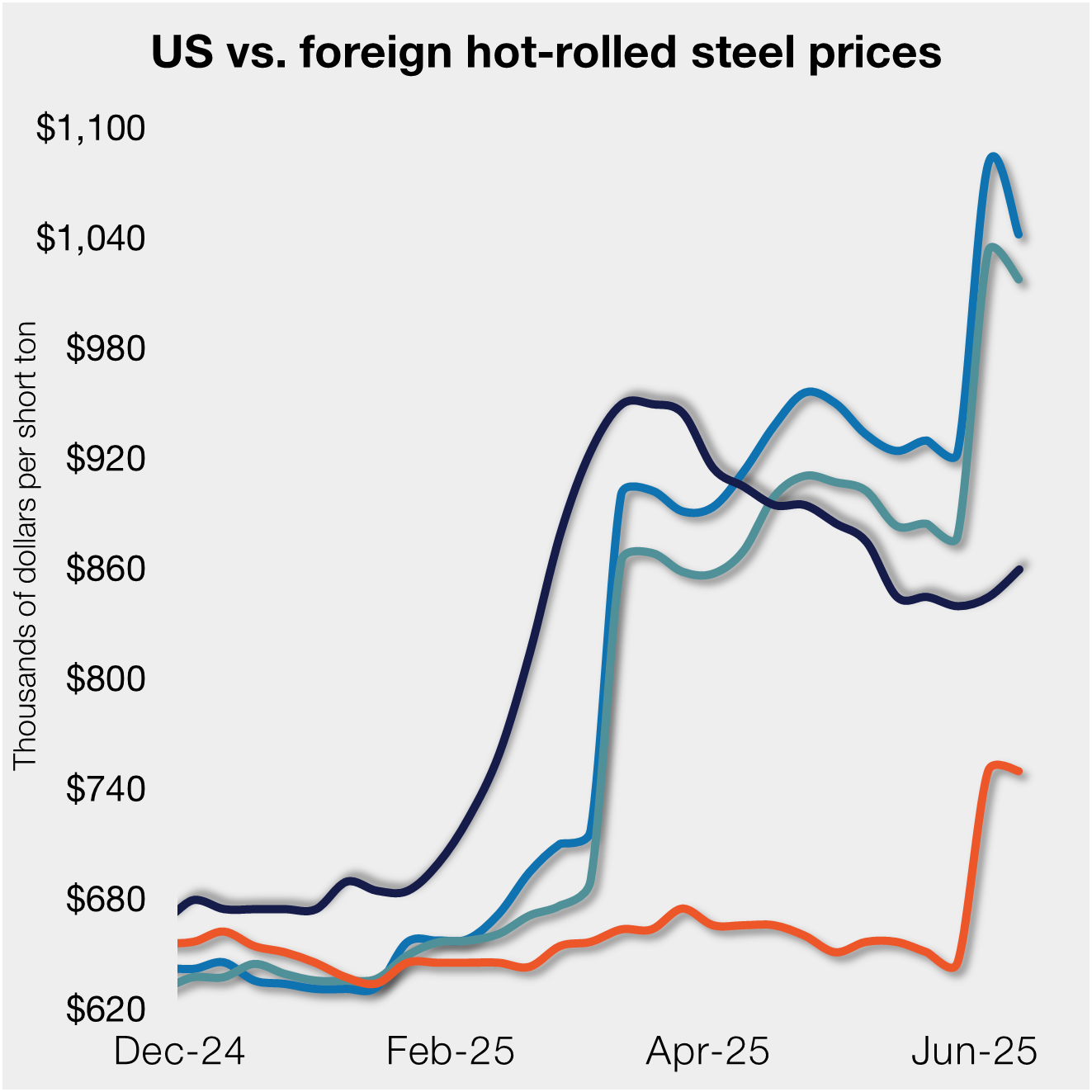International Steel Prices

CRU: Steel Prices Down as China Tries to Rebalance
Written by George Pearson
April 2, 2020
By CRU Prices Analyst George Pearson, from the CRU Steel Monitor
As expected, sheet prices in the U.S. Midwest market have fallen. Prices today, reflective of transactions booked last week, fell by $13-26 /s.ton w/w. For all sheet prices, we continue to hear of lower priced offers and expect that transaction prices will continue to fall over the near term. HR coil prices fell $13 /s.ton to $548 /s.ton. Overall volume reported to us was just under the prior week, yet with data coming through from multiple buyers and mills, the market remains liquid. If we come across a week where liquidity is truly limited, we have provisions in our methodology to continue to assess a price.
We continue to expect lower scrap prices for April, which will pressure finished steel prices alongside the overall curtailment of demand due to Covid-19. Plate prices turned lower again after a brief respite last week. Prices here fell to a new cycle low, losing $15 /s.ton w/w. Our price assessment for plate was based on higher volume than last week and while some data providers were steady and others higher w/w, the majority were lower.
European prices showed another gradual decrease this week. Spot business has dried up and so although the market expects lower prices, and those in the regions around Europe have fallen significantly, sellers see no advantage in quoting lower prices when buyers are unlikely to purchase. The absence of several companies in Italy—normally Europe’s prime mover for price—is also part of the reason for lack of downward movement in prices as there is less liquidity. German HR coil stood at €472 /t this week, down €3 /t w/w. Italian HR coil was unchanged at €443 /t but other products there fell €4–5 /t. The Italian plate price is now at its lowest since Jan. 8 and €22 /t above the low point it reached last year. The Italian government has extended the shutdown of schools and non-strategic businesses until mid-April.
The Chinese HR coil price fell by RMB120 /t to RMB3280 /t w/w, while rebar decreased by RMB100 /t. Flat prices took a heavier hit for a few reasons. Although domestic demand during March improved, it was still at a low level. The Caixin China manufacturing PMI rose to 50.1 in March from 40.3 in February. This figure implies that business only grew slightly compared to February, when the economy was largely at a halt. Flats-intensive end-use sectors such as automotive and manufacturing were especially impacted. In addition to this, some steel export orders were cancelled, and exports of manufactured products were lower.
As for the longs, although the market was less impacted by overseas demand, domestic demand recovery was lower than expected. Specifically, the “new infrastructure” projects put forward to offset the economic impact of Covid-19 offered limited support to steel consumption, because these projects were focused on innovation initiatives such as big data, artificial intelligence, driverless cars and quantum computing. Therefore, the earlier enthusiasm driven by these projects started to fade.
The total inventory at the mills and traders decreased for the first time in the year in mid-March and continued to drop by 5 percent this week. Weekly output had increased by 2 percent w/w, but is still at low levels compared to same time last year. Looking ahead, steel prices remain under pressure but the improved demand expected in April will limit sharp price falls.

Request more information about this topic.
Learn more about CRU’s services at www.crugroup.com
George Pearson
Read more from George PearsonLatest in International Steel Prices

Higher US CR prices inch closer to EU, Japanese tags
US cold-rolled (CR) coil prices continued to tick higher this week, while offshore markets were mixed.

Stacked S232 keeps US HR prices below EU
US hot-rolled coil prices crept up again this week but still trail imports from Europe.

Doubled S232 lifts EU, Japanese CR prices over US tags
US cold-rolled (CR) coil prices edged up again this week, and most offshore markets moved in the opposite direction. But the diverging price moves stateside vs. abroad did little to impact pricing trends. The bigger impact was from Section 232, which were doubled to 50% as of June 3. The higher tariffs have resulted in […]

CRU: Sheet demand remains weak, tariff changes again alter markets
Subdued demand has continued to weigh on steel sheet prices globally.

Higher S232 keeps US HR prices at a discount to EU
Domestic hot-rolled (HR) coil prices edged up marginally again this week, while offshore prices ticked down.
